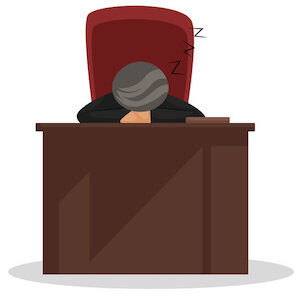By Dr. Ken Broda Bahm:

If you remember even a few images from kindergarten, you probably remember the time when your teachers would lay out the mats — that was the cue that it is naptime. One might say that the similar cue in a courtroom is when one side or the other cues up the pre-recorded video testimony to present to the jury. Because it is just a record of a past event that isn’t live, and because the witness is on-screen rather than in person, it doesn’t grab and hold attention like live examination. Some jurors see it as a chance to dial down their attention, and even if they aren’t literally sleeping, they’re less likely to be paying full attention.
That is a shame, and potentially a danger to your case. While I generally advise, “if it is important, than present it through a live witness” (with the corollary being, “and, if it isn’t important, then why show it at all?”) I do understand that sometimes presenting recorded testimony is inescapable. It may be preservation testimony for someone who is no longer available, or with judges pressing to streamline trials, it may be a necessary concession for a shorter curated bit of deposition to be used in lieu of bringing the person in for what would probably be longer testimony. But none of that makes it easier for the jury to avoid tuning out. For this post, I wanted to share five ways to make recorded testimony more engaging and less sleep-inducing when it does need to be presented.
- Start During the Deposition
Naturally, it helps if the recorded testimony you are showing is clear and engaging to jurors, so it starts with the deposition. That is why, when taking a deposition, attorneys should conduct the questioning with an eye toward the reality that “This may someday be shown to a jury.” Keeping that in mind during the questioning means telegraphing your focus and structure (“I’m now going to ask you about…“), asking for clarification even when you don’t personally need it (“Please tell us what that means…”), and requesting that content be aimed at a future jury (“Please tell the jury why…“).
2. Keep it Short
The advantage of recorded testimony is that you can go through it with a fine-toothed comb, and use the opportunity to boil it down to the essentials. Cut out anything that can come in through a live witness, and try to limit the length of the testimony to just what is essential. It also makes sense to space it out: Rather than playing a number of videos back-to-back, it is going to be kinder to jurors to play the video interspersed with live witnesses. That variety gives you a better shot at keeping the jurors engaged.
3. Provide Some Context
From a communication standpoint, the best practice is to provide some context on who the witness is and what the testimony bears upon in a few initial remarks to the jury. If the judge lets you do that, this explanation will be useful in telling the jury what to listen for. The argument to the bench is that this kind of context-setting is often what happens at the beginning of a live examination, and those early questions can be reactive to what the jury has already heard in the case so far. Because the recorded testimony does not include that context-setting, it helps the jury to let counsel make a few remarks. If the judge doesn’t allow that, then you might preview the recordings in opening statement, or, if relevant, introduce the recorded witness through a prior live witness. For example, “In the coming days, jurors will be seeing video from Mr. Smith. Can you take a few moments and tell them who Mr. Smith is and what role he had in this transaction?”
4. Use Other Visuals
While you are playing video, chances are good that no one will be walking around in the courtroom. So take advantage of that by using the courtroom space to give jurors other things to look at. For example, it is a good idea to set up a second screen or monitor in order to use a live trial-technology operator to call up and highlight any documents that are mentioned in the recorded testimony. In addition, you can also put your timeline and your “Who Is Who” demonstrative on an easel as an aid in understanding names and placing dates that come up in the recorded testimony. That will also provide jurors with an extended period of time to study your demonstratives in the event that they tune out on the testimony.
5. Consider the Time of Day
The worst time to present video testimony to the jury is when they’re already tired, for example, after lunch or at the end of the day. Unfortunately, recorded testimony is often used to fill in gaps in the court schedule, which leads counsel to think, “We’ll just finish with this live witness and then fill in whatever time we have left at the end of the day with video.” That is understandable from a scheduling standpoint. But from a jury-attention standpoint, it can be a bad habit. If the recorded testimony is critical, try to play it in the morning while jurors are still fresh.
Even with all these steps, watching a lot of video can be a challenge for juries or judges. To avoid either a figurative or literal naptime, it helps to think of ways to help it go down a little easier.
Other Posts on Video Testimony:
- Adapt to Remote Communication (Including Testimony)
- Avoid Gaze Aversion in Your Deposition Video
- Put Your Best Foot-in-Mouth Forward: Use Depo Video Powerfully
- Experts: Testify Remotely Without Losing Influence
Image credit: 123rf.com, used under license